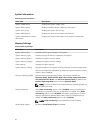
Menu Item Description
management is controlled by the OS Demand
Based Power Management (DBPM) and the
System DBPM Performance per Watt (DAPC).
By default, the option is set to Disabled.
System Security
Table 20. System Security
Menu Item Description
Intel AES-NI Improves the application speed by performing
encryption and decryption using the Advanced
Encryption Standard Instruction Set and is set to
Enabled by default.
System Password Allows you to set the system password. This option
is set to Enabled by default, and is read-only if the
password jumper is not installed in the system.
Setup Password Allows you to set the setup password. This option
is read-only if the password jumper is not installed
in the system.
Password Status Allows you to lock the system password. By
default, the Password Status option is set to
Unlocked.
TPM Security Allows you to control the reporting mode of the
Trusted Platform Module (TPM). By default, the
TPM Security option is set to Off. You can modify
only the TPM Status, TPM Activation , and Intel TXT
fields if the TPM Status field is set to either On with
Pre-boot Measurements or On without Pre-boot
Measurements.
TPM Activation Allows you to change the operational state of the
TPM. By default, the TPM Activation option is set
to No Change.
TPM Status Displays the TPM status.
TPM Clear
CAUTION: Clearing the TPM results in the
loss of all keys in the TPM. The loss of TPM
keys may affect booting to the operating
system.
Allows you to clear all the contents of the TPM. By
default, the TPM Clear option is set to No.
Intel TXT Allows you to enable or disable Intel Trusted
Execution Technology (TXT). To enable Intel TXT,
you must enable Virtualization Technology and
TPM Security must be Enabled with Pre-boot
27


















